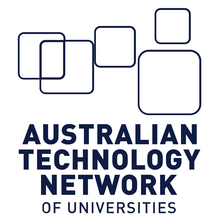Australian Technology Network
The Australian Technology Network (ATN) is a network of four Australian universities, with a history of working closely with industry. The ATN traces its origins back to 1975 as the Directors of Central Institutes of Technology (DOCIT), and was revived in 1998 in its present form.
 | |
| Formation | 1998 |
|---|---|
| Headquarters | Canberra, ACT |
Region served | Australia |
Membership | |
Chair | Attila Brungs |
| Website | http://www.atn.edu.au/ |
All ATN member universities are featured in the Times Higher Education's "Top 100 universities under 50 years old". Together, they produce 20 percent of all Australian graduates.[1]
History
The ATN originated in 1975 as the "Directors of Central Institutes of Technology (DOCIT)", a conference group consisting of the directors of Australia's leading "institutes of technology". Each of DOCIT's original member institutions (NSWIT, QIT, RMIT, SAIT and WAIT) were located in the central business district of their respective state's capital city, hence they were deemed "central institutes of technology".
DOCIT founded its original member institutes' distinctiveness on their size (they enrolled almost one third of all full-time advanced education students), on the advanced level of their teaching (most of their programs were degrees rather than the diplomas like that of other advanced education institutions) and their conduct of applied research (DEET, 1993:18). They were therefore like a "technology-focused" group.
DOCIT encountered too much opposition to its aspirations, and disbanded in 1982. The conference group was later revived in 1999 as the Australian Technology Network, consisting of: the Curtin University of Technology, Queensland University of Technology, Royal Melbourne Institute of Technology, University of South Australia and University of Technology Sydney. Each ATN member university was granted public university status between 1986 and 1992, however their antecedents make them some of the oldest tertiary institutions in Australia.
The departure of QUT from ATN was announced on 28 September 2018[2].
Today the ATN's member universities enroll around 180,000 students and 1 in 4 international students in Australia.[3] Its aim today is to help secure Australia’s reputation as the "clever country", contributing to its social and economic wealth by building strategic partnerships and undertaking solution-based research which is relevant to the expectations of industry and the community.[3]
Members
| University | Location | State | Established | University Status | THE World University Rankings 2020[4] | Academic Ranking of World Universities 2019[5] | QS World University Rankings 2021[6] | QS Top 50 Under 50 World Young University Rankings 2019[7] | THE 250 Under 50 World Young University Rankings 2019[8] |
|---|---|---|---|---|---|---|---|---|---|
| Curtin University | Perth | WA | 1902 | 1986 | 251-300 | 201-300 | 217= | 20 | 55= |
| RMIT University | Melbourne | VIC | 1887 | 1992 | 351-400 | 301-400 | 223= | 21 | 98= |
| University of South Australia (UniSA) | Adelaide | SA | 1856 | 1991 | 251-300 | 501-600 | 295= | 25 | 26= |
| University of Technology Sydney (UTS) | Sydney | NSW | 1964 | 1988 | 194= | 201-300 | 133= | 10 | 13 |
See also
- List of universities in Australia
- Group of Eight
- Innovative Research Universities Australia
- Regional Universities Network
- Australian Vice-Chancellors' Committee
- Golden Triangle (English universities)
- National Institutes of Technology (leading Indian engineering universities)
References
- "Fast facts". Australian Technology Network. Retrieved 23 June 2019.
- ATN Membership Change Retrieved 4 October 2018.
- About the ATN - ATN Homepage Archived 14 October 2008 at the Wayback Machine
- Times Higher Education World University Rankings 2019 Retrieved 26 September 2018.
- Academic Ranking of World Universities 2018 Retrieved 15 August 2018.
- QS World University Rankings 2021 Retrieved 21 June 2020.
- QS Top 50 Under 50 years World Young University Rankings 2019 Retrieved 23 June 2018.
- Times Higher Education 250 Under 50 years World Young University Rankings 2018 Retrieved 23 June 2018.
